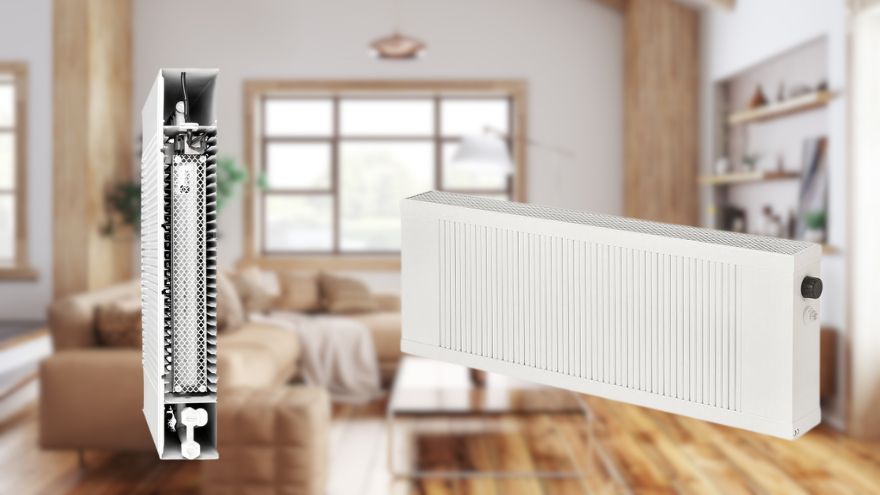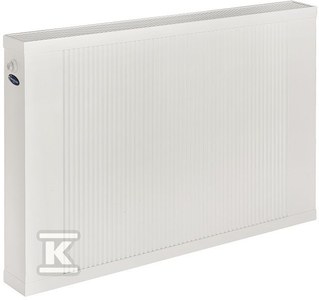Low-temperature and high-temperature heating are variants that can be installed to heat an apartment, house or any other facility. What are the characteristics of low-temperature heating, what radiators are dedicated to this solution and what are the differences between low- and high-temperature solutions?

Check out Regulus Sollarius E-Vent radiators at the Onninen wholesaler
What are the characteristics of low-temperature heating?
A modern solution that is increasingly used to heat buildings is low-temperature heating. It is becoming more and more popular every year. The most important feature is the ability to operate at significantly lower temperatures than classic heating systems, which makes these solutions much more advantageous, allowing for increased energy efficiency.
 In practice, this means that by using low-temperature radiators you can actually save on heating costs. This solution also brings many benefits in terms of environmental protection. The modern solutions used allow for a significant reduction in carbon dioxide emissions into the atmosphere.
In practice, this means that by using low-temperature radiators you can actually save on heating costs. This solution also brings many benefits in terms of environmental protection. The modern solutions used allow for a significant reduction in carbon dioxide emissions into the atmosphere.
In low-temperature installations, the heating medium, which is most often water, does not exceed 55 degrees. For the entire system to function efficiently, individual components, including radiators, must be properly prepared and installed.
What are low-temperature radiators?
Low-temperature heating systems use special types of radiators, which differ from classic solutions, including: construction. It is the design, as well as the relatively large heat exchange surface (especially in relation to size) that are the characteristic feature. Some models can even be equipped with special, built-in fans that create forced air movement.
 Low-temperature radiators have been designed and prepared in such a way as to respond to the needs of the installation, to ensure maximum efficiency in heat exchange, and thus ensure effective heating of the house. The surface of the elements in low-temperature radiators is as large as possible, and at the same time the water capacity of the radiators is limited as much as possible. What does this mean in practice? That there is no need to use as much water to obtain the right temperature as in classic solutions and it does not have a negative impact on the temperature felt in the rooms.
Low-temperature radiators have been designed and prepared in such a way as to respond to the needs of the installation, to ensure maximum efficiency in heat exchange, and thus ensure effective heating of the house. The surface of the elements in low-temperature radiators is as large as possible, and at the same time the water capacity of the radiators is limited as much as possible. What does this mean in practice? That there is no need to use as much water to obtain the right temperature as in classic solutions and it does not have a negative impact on the temperature felt in the rooms.
This effect can be achieved in various ways - by using appropriate radiation, thanks to which heat spreads around the room. This eliminates unnecessary air movement that could cause excessive dust to rise. The use of radiation allows for pleasant thermal comfort. An alternative is to use materials with a high degree of thermal conductivity in the production process, which supports the "release" of heat to the environment.
A perfect example of low-temperature radiators are products prepared by the Regulus brand. These are solid and durable proposals that allow you to make the most of the opportunities offered by the development of modern heating methods. Also important is the modern design, which will work great in any arrangement.
Regulus Sollarius and Dubel low-temperature radiators are currently very popular. In addition to their great appearance, they are also characterized by high heating efficiency and quality of workmanship. The second equally popular solution are products from the Regulus System Sollarius E-Vent and Revers series, a characteristic feature is the combination of the functions of a radiator and a fan. This way, you can ensure optimal conditions in the room.
Low-temperature and high-temperature radiators - differences
The choice of low-temperature and high-temperature radiators depends primarily on the type of heating installed. Depending on the boiler and fuel used, radiators are selected compatible with the entire system.
 For heating to be effective, in high-temperature systems, radiators must be supplied with a temperature of at least 50-55 degrees, while in low-temperature systems, the goal is to maintain appropriate efficiency while limiting the temperature. This means that the maximum level is 55 degrees, but this is the upper limit, because in most cases a temperature of 40-45 degrees is enough to heat. This effect is achieved by increasing the heating surface of the radiator.
For heating to be effective, in high-temperature systems, radiators must be supplied with a temperature of at least 50-55 degrees, while in low-temperature systems, the goal is to maintain appropriate efficiency while limiting the temperature. This means that the maximum level is 55 degrees, but this is the upper limit, because in most cases a temperature of 40-45 degrees is enough to heat. This effect is achieved by increasing the heating surface of the radiator.
The basic difference between high and low temperature variants is related primarily to energy efficiency and environmental impact. Another big advantage is the impact of low-temperature radiators on people's health and well-being.
Check out Regulus Sollarius radiators at the Onninen wholesaler